Are you a Quiet Speculation member?
If not, now is a perfect time to join up! Our powerful tools, breaking-news analysis, and exclusive Discord channel will make sure you stay up to date and ahead of the curve.
Most of the buzz to come out of GP Charlotte was on the awesome decks in the Top 16. Ad Nauseam combo? Elves? Griselbrand? Did we just wander into a Legacy tournament? Or maybe a kitchen table match, with stuff like Nourishing Shoal and Codex Shredder? Twin, Affinity, Burn, and all the familiar top-tier faces may have been out in force, but it was the innovative and crazy decks that snagged the spotlight. In this article, however, I don't want to look at the decks themselves. Instead, I want to dig a level deeper and look at some interesting and exciting cards that stole the stage at GP Charlotte.
Modern may be a format defined by cards like Tarmogoyf, Snapcaster Mage, and Lightning Bolt, but it's also defined by players who pioneer new uses for old cards. This article picks out some of the better technology from GP Charlotte, looking for cards that could find home in either sideboards, or even maindecks, elsewhere in the format. Some of these cards you will recognize from past seasons, hopefully finding new appreciation for them after the GP. Other cards have rarely been used in Modern before, although they may have new homes after this past weekend.
[wp_ad_camp_1]
Darkness (and company)
 One of the funnier moments at GP Charlotte came in the 13th round, when Ad Nauseam pilot Darien Elderfield was facing off against Infect specialist Ken Van Sciver. While building up a huge mana advantage in game 2, Elderfield was staring down a number of Infect creatures and needed to buy time. Van Sciver swung and Elderfield cast Darkness. But not the time-shifted version from Time Spiral. This was the black-bordered Legends copy, and the look on your face now as you try and interpret the picture to the left was basically Van Sciver's as he tried to figure out what this card did. Or what its art depicted. Or what a card with a 1994 copyright line was doing in a 2015 GP.
One of the funnier moments at GP Charlotte came in the 13th round, when Ad Nauseam pilot Darien Elderfield was facing off against Infect specialist Ken Van Sciver. While building up a huge mana advantage in game 2, Elderfield was staring down a number of Infect creatures and needed to buy time. Van Sciver swung and Elderfield cast Darkness. But not the time-shifted version from Time Spiral. This was the black-bordered Legends copy, and the look on your face now as you try and interpret the picture to the left was basically Van Sciver's as he tried to figure out what this card did. Or what its art depicted. Or what a card with a 1994 copyright line was doing in a 2015 GP.
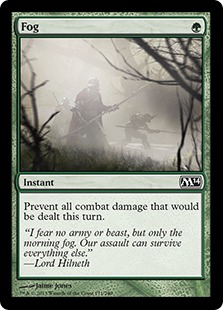 Elderfield would go on to win the matchup and make it to the Top 8. A big part of his strategy were the 3 copies of Darkness in the sideboard of his Ad Nauseam combo list. Fog effects have always seen some play in competitive formats, most recently in the Maze's End decks of Return to Ravnica Standard, or their Turbo Fog predecessors from the Innistrad era. These kind of combat damage-prevention tricks are excellent in decks that need to buy a quick turn to set themselves up for the big win, but they have been largely absent in Modern. Although good against Affinity and Infect, the cards seemed weak against countermagic heavy Twin (it's a temporary solution and it folds to countermagic like maindecked Dispel) and weak against Burn decks that finished you off outside of combat. Because of this, most Modern decks avoided both Fog and its variants like Darkness and Holy Day.
Elderfield would go on to win the matchup and make it to the Top 8. A big part of his strategy were the 3 copies of Darkness in the sideboard of his Ad Nauseam combo list. Fog effects have always seen some play in competitive formats, most recently in the Maze's End decks of Return to Ravnica Standard, or their Turbo Fog predecessors from the Innistrad era. These kind of combat damage-prevention tricks are excellent in decks that need to buy a quick turn to set themselves up for the big win, but they have been largely absent in Modern. Although good against Affinity and Infect, the cards seemed weak against countermagic heavy Twin (it's a temporary solution and it folds to countermagic like maindecked Dispel) and weak against Burn decks that finished you off outside of combat. Because of this, most Modern decks avoided both Fog and its variants like Darkness and Holy Day.
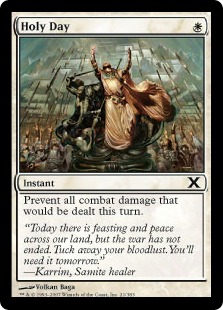 Elderfield's use of the card will likely cause some players to reconsider these cards. I had a lot of success with Darkness in the past when I played Mill (don't judge: everyone played Mill at least once), and I think the Fog effects are a lot more viable than people give credit. They are excellent in strategies that just need one more turn to win the game, but are otherwise soft to the more mainstream turn 3-4 decks like Affinity, Infect, and Twin. Strategies benefitting from Fogs could include numerous rogue turn 4 combo decks like Possibility Storm, Jeskai Ascendancy, Enduring Ideal/Enchantress, Time Walk combo, Nykthos Green/Tooth and Nail, etc. These turn 4 decks tend to fail because they are often just worse versions of Twin. Darkness and company give them an edge here, allowing them to buy a turn against three huge tier 1 decks to set up their own plan and force an overextension. The cards are particularly strong against Affinity and Infect, where they can screw up combat math and set an overcommitted opponent back multiple turns. Fogging a Become Immense is effectively a Time Stretch on an Infect player, and can have a similar effect on Affinity if paired with disruption. As more rogue combo decks try to break into the Modern scene, I expect them to leverage Darkness and its variants to give them a leg up.
Elderfield's use of the card will likely cause some players to reconsider these cards. I had a lot of success with Darkness in the past when I played Mill (don't judge: everyone played Mill at least once), and I think the Fog effects are a lot more viable than people give credit. They are excellent in strategies that just need one more turn to win the game, but are otherwise soft to the more mainstream turn 3-4 decks like Affinity, Infect, and Twin. Strategies benefitting from Fogs could include numerous rogue turn 4 combo decks like Possibility Storm, Jeskai Ascendancy, Enduring Ideal/Enchantress, Time Walk combo, Nykthos Green/Tooth and Nail, etc. These turn 4 decks tend to fail because they are often just worse versions of Twin. Darkness and company give them an edge here, allowing them to buy a turn against three huge tier 1 decks to set up their own plan and force an overextension. The cards are particularly strong against Affinity and Infect, where they can screw up combat math and set an overcommitted opponent back multiple turns. Fogging a Become Immense is effectively a Time Stretch on an Infect player, and can have a similar effect on Affinity if paired with disruption. As more rogue combo decks try to break into the Modern scene, I expect them to leverage Darkness and its variants to give them a leg up.
Magus of the Moon
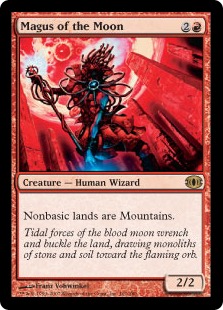 In this current metagame, I could probably write a Blood Moon article every week and still not run out of things to say. Decks are worse off if they lack access to Moon, which is bad news for those non-red decks that can't run it (or decks with other card restrictions, like Collected Company-powered strategies). Thankfully, another Time Spiral block oddball is here to save the day for those decks that can't run Moon. Enter the Moon's worshiper, Magus of the Moon. Magus saw two Top 16 appearances this past weekend. The first was in the sideboard of Paul Rietzl's 10th place Naya Company deck, a two-of supplemented by a singleton enchantment Moon. The second was as a maindeck bullet in Mark Klusa's 14th place Abzan Company list.
In this current metagame, I could probably write a Blood Moon article every week and still not run out of things to say. Decks are worse off if they lack access to Moon, which is bad news for those non-red decks that can't run it (or decks with other card restrictions, like Collected Company-powered strategies). Thankfully, another Time Spiral block oddball is here to save the day for those decks that can't run Moon. Enter the Moon's worshiper, Magus of the Moon. Magus saw two Top 16 appearances this past weekend. The first was in the sideboard of Paul Rietzl's 10th place Naya Company deck, a two-of supplemented by a singleton enchantment Moon. The second was as a maindeck bullet in Mark Klusa's 14th place Abzan Company list.
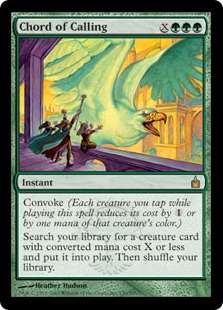 As I discussed in my GP Charlotte review article on Tuesday, Company decks are going to be big going into the rest of the summer. This isn't just hype: it's a legitimate metagame trend. And if Company decks are going to have a fighting chance in this metagame, they to need to leverage Moon without screwing up their Company flips. It's a testament to the power of Magus that Klusa chose to run it in a deck without a single source of land-based red mana. This is in part due to the Birds of Paradise colorfixing, which also helps accelerate you into the powerful turn 2 Moon effect. But it's also due to Company itself and, most importantly, Chord of Calling. One of the biggest problems with Moon in Modern is unreliability. Numerous players at Charlotte complained about not having a narrow sideboard answer when they needed it, and this is particularly important with Moon. Company decks get around that by playing 4 tutors for Magus (effectively running 5 copies right there), and then 4 additional Company cards to try and flip Magus off the top. Very few decks can support 4 maindeck Moons because that's not a card you want to run in multiples. In Company decks, Magus lets you effectively run 5 copies, which is a huge strength that only Company-powered decks can lean on.
As I discussed in my GP Charlotte review article on Tuesday, Company decks are going to be big going into the rest of the summer. This isn't just hype: it's a legitimate metagame trend. And if Company decks are going to have a fighting chance in this metagame, they to need to leverage Moon without screwing up their Company flips. It's a testament to the power of Magus that Klusa chose to run it in a deck without a single source of land-based red mana. This is in part due to the Birds of Paradise colorfixing, which also helps accelerate you into the powerful turn 2 Moon effect. But it's also due to Company itself and, most importantly, Chord of Calling. One of the biggest problems with Moon in Modern is unreliability. Numerous players at Charlotte complained about not having a narrow sideboard answer when they needed it, and this is particularly important with Moon. Company decks get around that by playing 4 tutors for Magus (effectively running 5 copies right there), and then 4 additional Company cards to try and flip Magus off the top. Very few decks can support 4 maindeck Moons because that's not a card you want to run in multiples. In Company decks, Magus lets you effectively run 5 copies, which is a huge strength that only Company-powered decks can lean on.
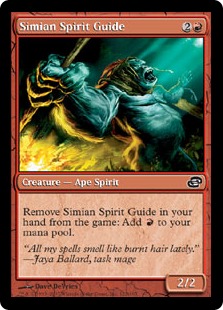 Company and Chord may be Magus's natural home, but the Wizard will also find a home outside of these decks. Charlotte proved the power of Moon, both in the matchups where it was supposed to work (Amulet Bloom being the big one), and in matchups where it has always been relevant (Abzan, Zoo, Jund, etc.). Because of this, I expect to see more decks either using Magus on his own as an aggressive body with an upside, or as part of a deck that can run multiple Moons and try to drop one early. In the first case, we could definitely see Magus as part of an RG Human or Werewolves deck (which might end up actually being another Company deck: future brew, anyone??). But we can also use it in a red-based Moon deck that is already trying to accelerate into redundant, early threats. Simian Spirit Guide can ensure either the turn 2 Magus/Moon, or the turn 1 Chalice of the Void at 1. This kind of strategy can be very effective in certain metagames, and I expect more players to try it as Moon continues to prove its worth in Modern.
Company and Chord may be Magus's natural home, but the Wizard will also find a home outside of these decks. Charlotte proved the power of Moon, both in the matchups where it was supposed to work (Amulet Bloom being the big one), and in matchups where it has always been relevant (Abzan, Zoo, Jund, etc.). Because of this, I expect to see more decks either using Magus on his own as an aggressive body with an upside, or as part of a deck that can run multiple Moons and try to drop one early. In the first case, we could definitely see Magus as part of an RG Human or Werewolves deck (which might end up actually being another Company deck: future brew, anyone??). But we can also use it in a red-based Moon deck that is already trying to accelerate into redundant, early threats. Simian Spirit Guide can ensure either the turn 2 Magus/Moon, or the turn 1 Chalice of the Void at 1. This kind of strategy can be very effective in certain metagames, and I expect more players to try it as Moon continues to prove its worth in Modern.
Thragtusk
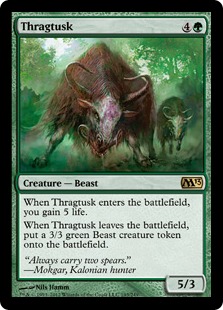 I didn't play Standard during the reign of Thragtusk (I actually don't remember the last time I played Standard period), but the green Beast has proved its worth well beyond its early days. Unlike Darkness and Magus, Thragtusk has seen a respectable amount of Modern play in recent years. GP Charlotte saw the card appear in Amulet Bloom decks, such as Alexander Hayne's 17th place build, Jund, Temur Twin, and even as a maindecked bullet in the winning Elves list. In all cases, Thragtusk served the same function even if its context changed. The Beast remains one of the most cost-efficient ways to go over the top of fair and grindy decks, and for stabilizing board states. It's just impossible to interact profitably with this card. It trades with Tasigur and the average Goyf (not to mention Rhino, despite Abzan's flagging metagame share). It also kickstarts life totals and puts a body on the board. You really can't remove this card without 2-for-1ing yourself, and definitely can't hit it off Lily. Tusk is particularly strong against decks without lots of creatures to actually block the 3/3 mini-Beast, where an opponent is virtually guaranteed to emerge from a Thragtusk fight at card disadvantage: nothing feels worse than Bolting that token.
I didn't play Standard during the reign of Thragtusk (I actually don't remember the last time I played Standard period), but the green Beast has proved its worth well beyond its early days. Unlike Darkness and Magus, Thragtusk has seen a respectable amount of Modern play in recent years. GP Charlotte saw the card appear in Amulet Bloom decks, such as Alexander Hayne's 17th place build, Jund, Temur Twin, and even as a maindecked bullet in the winning Elves list. In all cases, Thragtusk served the same function even if its context changed. The Beast remains one of the most cost-efficient ways to go over the top of fair and grindy decks, and for stabilizing board states. It's just impossible to interact profitably with this card. It trades with Tasigur and the average Goyf (not to mention Rhino, despite Abzan's flagging metagame share). It also kickstarts life totals and puts a body on the board. You really can't remove this card without 2-for-1ing yourself, and definitely can't hit it off Lily. Tusk is particularly strong against decks without lots of creatures to actually block the 3/3 mini-Beast, where an opponent is virtually guaranteed to emerge from a Thragtusk fight at card disadvantage: nothing feels worse than Bolting that token.
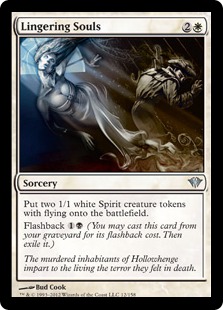 There are two places I see Thragtusk thriving through the end of the year. The first, and most obvious, is as a continued sideboard answer to certain decks. Thragtusk caused huge problems for fair decks all weekend, and I would expect lots of green-based fair decks to start running the card. Even Abzan Company ran the beast at Charlotte (Klusa again: between Tusk and Magus, this man's a visionary), even though it has zero synergy with the deck's namesake spell. The card is much better now than it was back in February, when Lingering Souls tokens clogged up the board and allowed Abzan mages to ignore the Beast. Amulet Bloom was still running Tusk card back then, but apart from Reid Duke on his GP Vancouver Death Cloud list, the Beast wasn't that present. Today, the Soul-less Jund is the BGx deck in charge, which makes Tusk a much better choice going ahead. Add to that the rise of Grixis decks and you have a real monster. Seriously, what is a deck like Grixis Delver even supposed to do against this card?
There are two places I see Thragtusk thriving through the end of the year. The first, and most obvious, is as a continued sideboard answer to certain decks. Thragtusk caused huge problems for fair decks all weekend, and I would expect lots of green-based fair decks to start running the card. Even Abzan Company ran the beast at Charlotte (Klusa again: between Tusk and Magus, this man's a visionary), even though it has zero synergy with the deck's namesake spell. The card is much better now than it was back in February, when Lingering Souls tokens clogged up the board and allowed Abzan mages to ignore the Beast. Amulet Bloom was still running Tusk card back then, but apart from Reid Duke on his GP Vancouver Death Cloud list, the Beast wasn't that present. Today, the Soul-less Jund is the BGx deck in charge, which makes Tusk a much better choice going ahead. Add to that the rise of Grixis decks and you have a real monster. Seriously, what is a deck like Grixis Delver even supposed to do against this card?
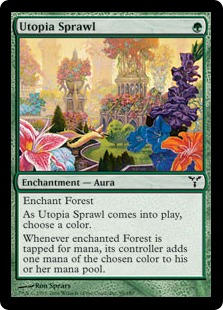 The second place where I see Thragtusk shining is in big mana decks. Currently, Modern has only two premier big mana decks in RG Tron and Amulet Bloom. And of those two, Amulet Bloom only really becomes this kind of over-the-top deck in games 2/3, when it sideboards in monsters like Tusk, Hornet Queen, and Dragonlord Dromoka to combat opponents who focus too heavily on stopping their combo. Following the impact of these decks in the early weeks of June, I believe more Modern players will start building these kinds of decks. In many respects, they will reflect Legacy's Nic Fit deck, although we don't have any Veteran Explorers and Cabal Therapys to play with. We do, however, have potent engines in the Bolt-proof "dork" of Utopia Sprawl, and his Bolt-magnet buddy Arbor Elf. We've seen a number of decks, primarily on MTGO, use this combo to facilitate early Tooth and Nails. That's a bit excessive and risky for my tastes, but the concept of a turn 3 Thragtusk is very exciting. Fair decks have a very hard time handling these kinds of threats, especially when paired with stuff like Cavern of Souls, a card that is increasingly valuable in a Grixis-defined metagame. If these ramp decks take off, Thragtusk will be a big part of it. Even if they don't, we will see more of this card in the decks that already exist in the metagame.
The second place where I see Thragtusk shining is in big mana decks. Currently, Modern has only two premier big mana decks in RG Tron and Amulet Bloom. And of those two, Amulet Bloom only really becomes this kind of over-the-top deck in games 2/3, when it sideboards in monsters like Tusk, Hornet Queen, and Dragonlord Dromoka to combat opponents who focus too heavily on stopping their combo. Following the impact of these decks in the early weeks of June, I believe more Modern players will start building these kinds of decks. In many respects, they will reflect Legacy's Nic Fit deck, although we don't have any Veteran Explorers and Cabal Therapys to play with. We do, however, have potent engines in the Bolt-proof "dork" of Utopia Sprawl, and his Bolt-magnet buddy Arbor Elf. We've seen a number of decks, primarily on MTGO, use this combo to facilitate early Tooth and Nails. That's a bit excessive and risky for my tastes, but the concept of a turn 3 Thragtusk is very exciting. Fair decks have a very hard time handling these kinds of threats, especially when paired with stuff like Cavern of Souls, a card that is increasingly valuable in a Grixis-defined metagame. If these ramp decks take off, Thragtusk will be a big part of it. Even if they don't, we will see more of this card in the decks that already exist in the metagame.
Shadow of Doubt
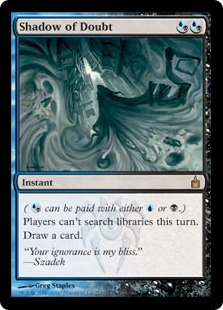 Back at Worlds 2013, a number of control players (notably Shahar Shenhar) used Shadow of Doubt in their sideboard or even maindeck. Like Thragtusk, Shadow is a card many Modern players are familiar with, the cantripping, instant-speed Sinkhole with bonuses against decks like the late Pod, the current Company decks, and big-mana builds like RG Tron and Amulet Bloom. Shadow saw some play in control decks back in the Treasure Cruise era, but it had mostly fallen out of favor by the time the January banlist announcements hit. But if I learned anything about control decks this weekend, it's to never underestimate Patrick Chapin paired with Cryptic Command, and that Shadow is still maindeck material in this current format.
Back at Worlds 2013, a number of control players (notably Shahar Shenhar) used Shadow of Doubt in their sideboard or even maindeck. Like Thragtusk, Shadow is a card many Modern players are familiar with, the cantripping, instant-speed Sinkhole with bonuses against decks like the late Pod, the current Company decks, and big-mana builds like RG Tron and Amulet Bloom. Shadow saw some play in control decks back in the Treasure Cruise era, but it had mostly fallen out of favor by the time the January banlist announcements hit. But if I learned anything about control decks this weekend, it's to never underestimate Patrick Chapin paired with Cryptic Command, and that Shadow is still maindeck material in this current format.
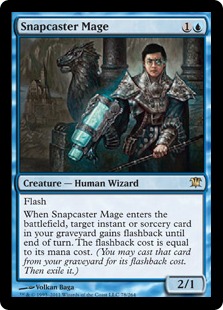 Chapin ran Shadow as a singleton bullet in his deck, following a similar strategy he used in maindecking a lone Dispel and Electrolyze. Given the field he was up against, however, he probably could have gone up to 2 Shadows and enjoyed nothing but success. Shadow of Doubt is very strong in this current metagame for a number of reasons. For one, there are lots of decks with search effects outside of fetchlands: RG Tron, Amulet Bloom, Company variants, etc. These decks constitute at least 15% of the metagame right now (our Top Decks page was updated yesterday to reflect these changes), and give Shadow a lot of game 1 play. These matchups also make Shadow an automatic one-of in sideboards for any deck aspiring to play a control gameplan. This brings us to the second reason Shadow is viable: the increased viability of control decks. For the longest time, UWR Control had been hanging on for dear life, with Esper Control and Cruel Control scrounging around near the bottom of tier 3. Grixis Control changed that. In a similar vein to Gerard Fabiano's Sultai Control list, back from SCG Baltimore, Grixis Control combines a decidedly reactive gameplan with some proactive elements. Tasigur, the Golden Fang and Gurmag Angler are huge here, and without these cards, the archetype could never have taken off. Paired with these proactive plan B's, the control staples of Cryptic Command and Snapcaster are able to shine anew. Reid Duke called Snapcaster the most powerful card in Modern (in an obnoxious banlist context, but we'll give him a pass on that), and Shadow plays into Tiago-based strategies nicely.
Chapin ran Shadow as a singleton bullet in his deck, following a similar strategy he used in maindecking a lone Dispel and Electrolyze. Given the field he was up against, however, he probably could have gone up to 2 Shadows and enjoyed nothing but success. Shadow of Doubt is very strong in this current metagame for a number of reasons. For one, there are lots of decks with search effects outside of fetchlands: RG Tron, Amulet Bloom, Company variants, etc. These decks constitute at least 15% of the metagame right now (our Top Decks page was updated yesterday to reflect these changes), and give Shadow a lot of game 1 play. These matchups also make Shadow an automatic one-of in sideboards for any deck aspiring to play a control gameplan. This brings us to the second reason Shadow is viable: the increased viability of control decks. For the longest time, UWR Control had been hanging on for dear life, with Esper Control and Cruel Control scrounging around near the bottom of tier 3. Grixis Control changed that. In a similar vein to Gerard Fabiano's Sultai Control list, back from SCG Baltimore, Grixis Control combines a decidedly reactive gameplan with some proactive elements. Tasigur, the Golden Fang and Gurmag Angler are huge here, and without these cards, the archetype could never have taken off. Paired with these proactive plan B's, the control staples of Cryptic Command and Snapcaster are able to shine anew. Reid Duke called Snapcaster the most powerful card in Modern (in an obnoxious banlist context, but we'll give him a pass on that), and Shadow plays into Tiago-based strategies nicely.
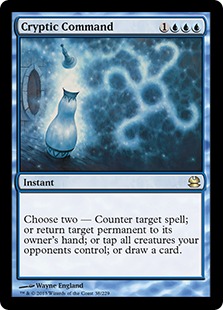 Another key strength of Shadow is its hybrid mana cost. Because of its natural synergy with Snapcaster and in blue-based control, players often forget that a blue-less deck can definitely cast this card. Although Shadow is less strong in decks without Snapcaster, and in decks without countermagic, it can still be a nice surprise in the more controlling versions of BGx decks. Of course, its home is always going to be the blue-based control decks. There are some players who are worried about the viability of blue-based control in Modern. When your only real control deck in the Top 32 is Chapin's, then yeah, that can be a reasonable worry. But having watched Chapin on camera and looked at the metagame, I think control is much more viable than people give it credit. Can you play a straight draw-go deck in Modern? Probably not, at least not with this card pool. But hey, you can't play every strategy in every format: just ask aggro (Zoo, Goblins, Merfolk) players in Legacy! As long as you are willing to have some kind of proactive element in your control deck (e.g. Goyf for Temur or Tasigur/Angler for Grixis), then the rest of your control shell should work just fine. Cryptic Command was outrageous at the GP, at least once its players got to turn 4. So long as you are using cards like Dispel and Shadow of Doubt to get you to turn 4, everything else should fall into place around those cards. I look forward to seeing more Shadows in control decks across the format, and more control generally after the GP. If nothing else, Sinkole is just as fun now as it was in the 90s.
Another key strength of Shadow is its hybrid mana cost. Because of its natural synergy with Snapcaster and in blue-based control, players often forget that a blue-less deck can definitely cast this card. Although Shadow is less strong in decks without Snapcaster, and in decks without countermagic, it can still be a nice surprise in the more controlling versions of BGx decks. Of course, its home is always going to be the blue-based control decks. There are some players who are worried about the viability of blue-based control in Modern. When your only real control deck in the Top 32 is Chapin's, then yeah, that can be a reasonable worry. But having watched Chapin on camera and looked at the metagame, I think control is much more viable than people give it credit. Can you play a straight draw-go deck in Modern? Probably not, at least not with this card pool. But hey, you can't play every strategy in every format: just ask aggro (Zoo, Goblins, Merfolk) players in Legacy! As long as you are willing to have some kind of proactive element in your control deck (e.g. Goyf for Temur or Tasigur/Angler for Grixis), then the rest of your control shell should work just fine. Cryptic Command was outrageous at the GP, at least once its players got to turn 4. So long as you are using cards like Dispel and Shadow of Doubt to get you to turn 4, everything else should fall into place around those cards. I look forward to seeing more Shadows in control decks across the format, and more control generally after the GP. If nothing else, Sinkole is just as fun now as it was in the 90s.
Pithing Needle
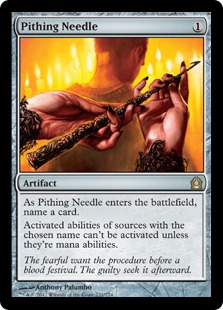 Lantern/Fateseal/Top Control is one of those zany Magic decks you expect to see at Modern FNMs. So when Zac Elsik piloted his list to a 15th place finish, the Modern community definitely took notice. There are lots of interesting cards in Elsik's deck including Surgical Extraction, Ensnaring Bridge (I could write a whole article on that card), and Duress, all in the maindeck and all taking him to the Top 16. But the card I want to focus on today is a sideboard bullet that has existed for years but is often passed over in favor of other, more direct threats: Pithing Needle. Needle is one of those cards you look at and immediately try to jam into your sideboard. Modern is just packed with activated abilities, so it seems like Needle would be the perfect answer for sideboards everywhere. And yet, the card almost never shows up, except for some random showings alongside cards like Tezzeret, Agent of Bolas and maybe Ancient Stirrings.
Lantern/Fateseal/Top Control is one of those zany Magic decks you expect to see at Modern FNMs. So when Zac Elsik piloted his list to a 15th place finish, the Modern community definitely took notice. There are lots of interesting cards in Elsik's deck including Surgical Extraction, Ensnaring Bridge (I could write a whole article on that card), and Duress, all in the maindeck and all taking him to the Top 16. But the card I want to focus on today is a sideboard bullet that has existed for years but is often passed over in favor of other, more direct threats: Pithing Needle. Needle is one of those cards you look at and immediately try to jam into your sideboard. Modern is just packed with activated abilities, so it seems like Needle would be the perfect answer for sideboards everywhere. And yet, the card almost never shows up, except for some random showings alongside cards like Tezzeret, Agent of Bolas and maybe Ancient Stirrings.
Fateseal Control (I'm going to bounce around on this name for a while, so bear with me) was obviously an incredibly specific application of Needle, but I think it's time for this card to take wings elsewhere. In a wide format like Modern where you can't possibly sideboard against every single deck, it's important to have versatile technology for handling overlapping matchups. This is why a card like Spellskite is so strong, or why blue decks run the Dispel/Negate/Flashfreeze package so regularly. Needle fits perfectly into that tradition. For just one mana, you get a proactive answer to all the following decks and their cards:
 RG Tron: Karn, Liberated, Oblivion Stone, Eye of Ugin
RG Tron: Karn, Liberated, Oblivion Stone, Eye of Ugin- Affinity: Cranial Plating, Inkmoth Nexus, Arcbound Ravager
- Jund/Abzan: Liliana of the Veil, Treetop Village, Raging Ravine/Stirring Wildwood, Scavenging Ooze
- Twin: Deceiver Exarch/Pestermite (do NOT name "Splinter Twin" or you will wind up as a reddit gif)
- Abzan Company: Viscera Seer, Spellskite, Scavenging Ooze, Gavony Township
And that's just looking at the tier 1 decks (and not even listing every card in those decks)! Going into tier 2 we find even more applications for Needle. This kind of versatile sideboard card is perfect for a lot of Modern decks who are afraid of only a few narrow cards but can't possibly find overlapping answers for all of them. Even if you aren't playing against decks with lots of activated abilities, you can still name different fetchlands to screw with mana development. Of course, I also don't want to overstate Needle's relevance in Modern. There's a reason that such a widely-known card hasn't seen play, and it's not just that players aren't willing to try new things. Needle is sometimes too specific, stopping a variety of threats but only one at a time. This makes it bad in decks that need to answer a diverse range of cards, but great in decks that just need to answer a few. Or great against decks that rely on a few activated abilities to win. I don't see Needle taking over the format, but I do see decks reexamining its value and putting a few copies in the board. Fateseal Control proved the card's viability and other players will look to try it in their own 75.
More GP Charlotte Technology?
 With all the awesome decks at the GP, it's easy to pull out interesting cards. I really liked the Tidehollow Sculler playset in Ian Bosley's 6th place Abzan Company list, just as it was really excited to see all the Knight of the Reliquarys in a format that had long declared her dead. This kind of technology shows that Modern is both much more open than many players assumed, and that the cardpool is still home to relevant cards that aren't seeing as much play as they should. What other cards piqued your curiosity? Any other tech you will be trying out ? I'm excited to continue the Modern extravaganza in June and look for even more cool cards coming out of the next few events.
With all the awesome decks at the GP, it's easy to pull out interesting cards. I really liked the Tidehollow Sculler playset in Ian Bosley's 6th place Abzan Company list, just as it was really excited to see all the Knight of the Reliquarys in a format that had long declared her dead. This kind of technology shows that Modern is both much more open than many players assumed, and that the cardpool is still home to relevant cards that aren't seeing as much play as they should. What other cards piqued your curiosity? Any other tech you will be trying out ? I'm excited to continue the Modern extravaganza in June and look for even more cool cards coming out of the next few events.


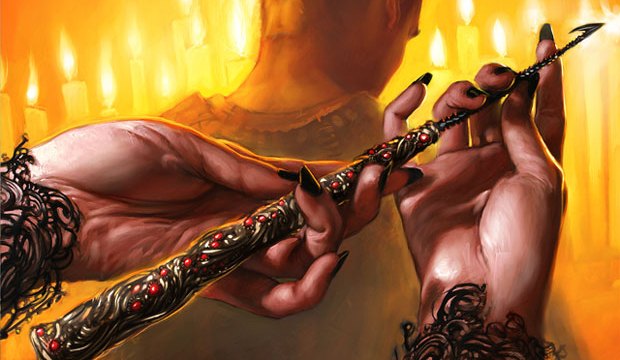



I think you missed the single biggest piece of tech in the top 8: Teferi coupled with Cavern of Souls.
It’s funny you mention it because I actually wanted to do a full article on Cavern of Souls. That card put in an insane amount of work this GP.
Like so much ur articles I found your page last night and i cant stop learn things . i like the articles becouse they are profound and complex , hight level magic here!
Glad you are enjoying the content! Let us know if there’s anything more you want to read about or see us analyze.
Shadow of Doubt does some serious work. As a burn player who often has to keep 1-land hands, having a control player shadow of doubt your fetch when you hit your 2nd land drop can be entirely crippling, especially since you know they are primed to flash it back in with a snapcaster if you happen to draw another fetch (which are typically over half your land drops).
Thanks for the article – looks like I’ll have to make room for both Fog effects and Shadow of Doubt in some of the control shells I was thinking about using (maybe play Sultai for ease of use?). Those cards put in real work at the GP.
Finally! Actual innovation modern. I was so sick of seeing “innovative” modern lists that took an established deck and jammed $600 worth of Gyof into it. (Tarmo twin, temur moon, affinigyof,)
Wow. Such innovation. -_-
No love for the 12-3 esper draw-go control list? It wasn’t in the top 32 only on breakers, but it performed exactly as well as a number of the decks in that top 32.
http://magic.wizards.com/en/events/coverage/gpcha15/archetype-exemplars-top-decks-of-grand-prix-charlotte-2015-06-13
also jeskai control in 33rd.
Amazing articles, the analysis is top notch and you are doing a service to the magic community on modern, keep it up!!
Magus of the Moon + Collected Company is such an obvious move now that someone has shown us the way. I’ve been using Tidehollow in Abzan, but hadn’t gotten up to the full playset yet. I’m at a 2/1 split with Sin Collector.
As for other tech not mentioned, U/B Fae actually using Faerie Harbinger is pretty nice. The card always seemed underwhelming, but when you really want to find a Mistbind, Spellstutter or Bitterblossom to lock up different game states, why not have “an extra”?